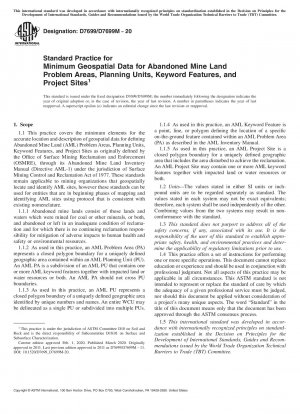ASTM D7699/D7699M-20
Standard Practice for Minimum Geospatial Data for Abandoned Mine Land Problem Areas, Planning Units, Keyword Features, and Project Sites
- Standard No.
- ASTM D7699/D7699M-20
- Release Date
- 2020
- Published By
- American Society for Testing and Materials (ASTM)
- Latest
- ASTM D7699/D7699M-20
- Scope
- 1.1 This practice covers the minimum elements for the accurate location and description of geospatial data for defining Abandoned Mine Land (AML) Problem Areas, Planning Units, Keyword Features, and Project Sites as originally defined by the Office of Surface Mining Reclamation and Enforcement (OSMRE), through its Abandoned Mine Land Inventory Manual (Directive AML-1) under the jurisdiction of Surface Mining Control and Reclamation Act of 1977. These standards remain applicable to mining organizations that geospatially locate and identify AML sites, however these standards can be used for entities that are in beginning phases of mapping and identifying AML sites using protocol that is consistent with existing nomenclature. 1.1.1 Abandoned mine lands consist of those lands and waters which were mined for coal or other minerals, or both, and abandoned or left in an inadequate condition of reclamation and for which there is no continuing reclamation responsibility for mitigation of adverse impacts to human health and safety or environmental resources. 1.1.2 As used in this practice, an AML Problem Area (PA) represents a closed polygon boundary for a uniquely defined geographic area contained within an AML Planning Unit (PU). An AML PA is a subdivision of an AML PU that contains one or more AML keyword features together with impacted land or water resources or both. An AML PA should not cross PU boundaries. 1.1.3 As used in this practice, an AML PU represents a closed polygon boundary of a uniquely defined geographic area identified by unique numbers and names. An entire WCU may be delineated as a single PU or subdivided into multiple PUs. 1.1.4 As used in this practice, an AML Keyword Feature is a point, line, or polygon defining the location of a specific on-the-ground feature contained within an AML Problem Area (PA) as described in the AML Inventory Manual. 1.1.5 As used in this practice, an AML Project Site is a closed polygon boundary for a uniquely defined geographic area that includes the area disturbed to achieve the reclamation. An AML Project Site may contain one or more AML keyword features together with impacted land or water resources or both. 1.2 Units—The values stated in either SI units or inchpound units are to be regarded separately as standard. The values stated in each system may not be exact equivalents; therefore, each system shall be used independently of the other. Combining values from the two systems may result in nonconformance with the standard. 1.3 This standard does not purport to address all of the safety concerns, if any, associated with its use. It is the responsibility of the user of this standard to establish appropriate safety, health, and environmental practices and determine the applicability of regulatory limitations prior to use. 1.4 This practice offers a set of instructions for performing one or more specific operations. This document cannot replace education or experience and should be used in conjunction with professional judgment. Not all aspects of this practice may be applicable in all circumstances. This ASTM standard is not intended to represent or replace the standard of care by which the adequacy of a given professional service must be judged, nor should this document be applied without consideration of a project’s many unique aspects. The word “Standard” in the title of this document means only that the document has been approved through the ASTM consensus process. 1.5 This international standard was developed in accordance with internationally recognized principles on standardization established in the Decision on Principles for the Development of International Standards, Guides and Recommendations issued by the World Trade Organization Technical Barriers to Trade (TBT) Committee. 1 This practice is under the jurisdiction of ASTM Committee D18 on Soil and Rock and is the direct responsibility of Subcommittee D18.01 on Surface and Subsurface Characterization. Current edition approved Feb. 1, 2020. Published March 2020. Originally approved in 2011. Last previous edition approved in 2011 as D7699/D7699M – 11. DOI: 10.1520/D7699_D7699M-20. Copyright © ASTM International, 100 Barr Harbor Drive, PO Box C700, West Conshohocken, PA 19428-2959. United States This international standard was developed in accordance with internationally recognized principles on standardization established in the Decision on Principles for the Development of International Standards, Guides and Recommendations issued by the World Trade Organization Technical Barriers to Trade (TBT) Committee.
ASTM D7699/D7699M-20 Referenced Document
- ASTM D653 Standard Terminology Relating to Soil, Rock, and Contained Fluids
ASTM D7699/D7699M-20 history
- 2020 ASTM D7699/D7699M-20 Standard Practice for Minimum Geospatial Data for Abandoned Mine Land Problem Areas, Planning Units, Keyword Features, and Project Sites
- 2011 ASTM D7699/D7699M-11 Standard Practice for Minimum Geospatial Data for Abandoned Mine Land Problem Areas, Planning Units, Keyword Features, and Project Sites
